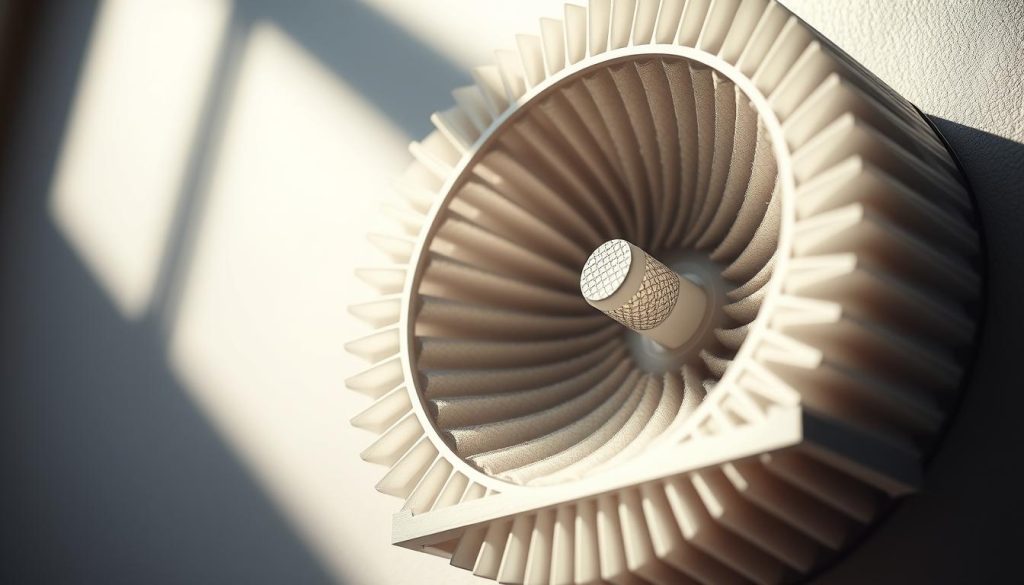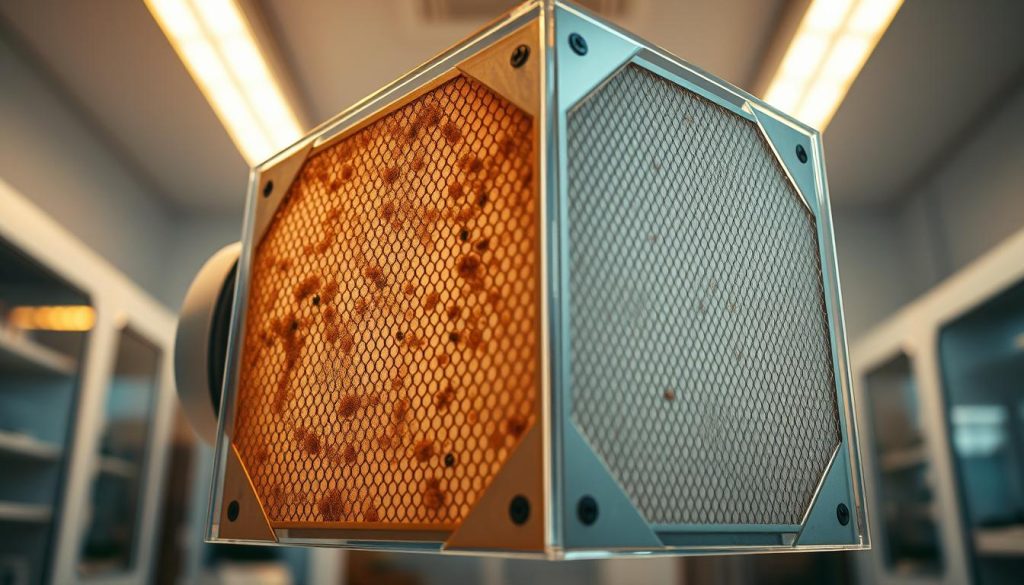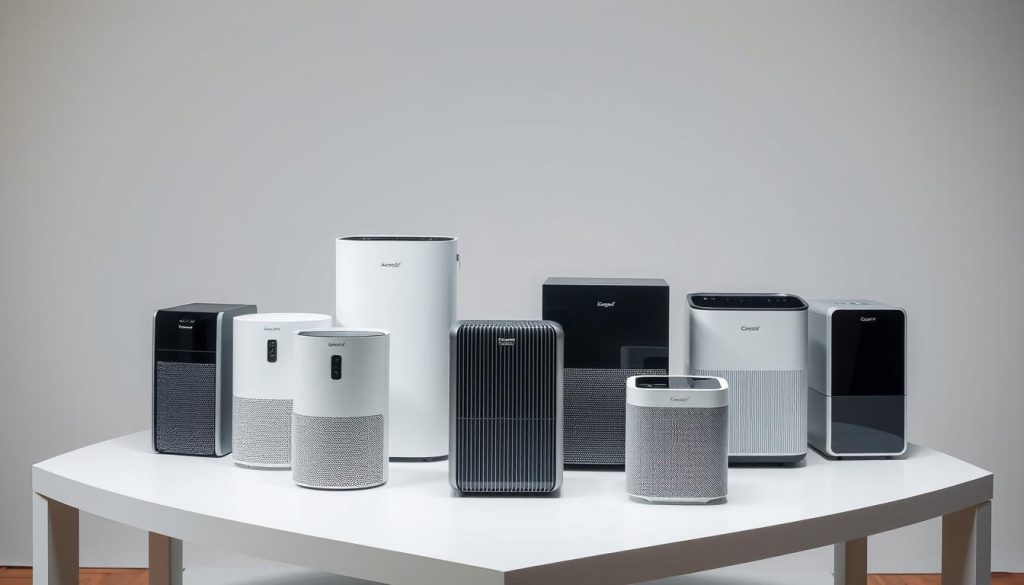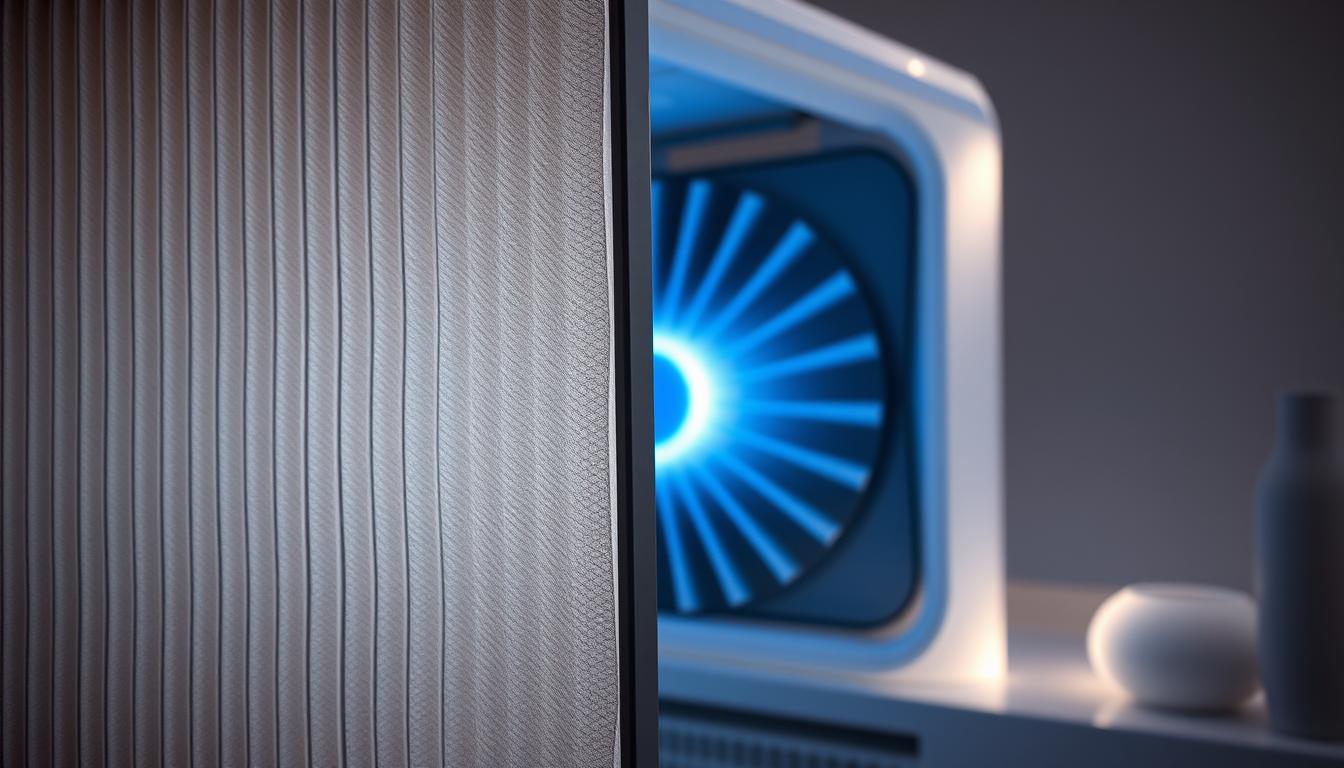Choosing the right air purifier can be tough with so many options. The debate is between negative ionizers and HEPA filters. They both aim to clean the air, but in different ways.
Negative ionizers use electrically charged particles to purify the air. On the other hand, HEPA filters use a mesh to catch pollutants. Each has its own benefits, and the best choice depends on your needs.
This article will dive into the details of both technologies. We aim to help you make a well-informed decision.
Understanding Air Purifier Technologies
Air purifiers are key in homes and offices today. They help clean the air we breathe. This is because people worry more about the air inside.
What Are Air Purifiers?
Air purifiers clean the air by removing bad stuff. They pull in air, clean it, and then send out fresh air. There are many types, like HEPA filters and negative ionizers, each with its own way of making air better.
Importance of Air Purification
Clean air is important for our health. Bad air can cause allergies, asthma, and other breathing problems. Air purifiers help get rid of dust, pollen, and even germs. This makes our homes and offices healthier places.
How Negative Ionizers Work
Negative ionizers help clean the air by releasing negative ions. These ions stick to dust and pollen, making them fall. This way, they remove harmful particles from the air we breathe. Knowing how they work shows the many benefits of ionizers.
Principle of Operation
Negative ionizers use electricity to create negative ions. These ions attract dust, pollen, and allergens, making them fall. This method cleans the air and lowers health risks from pollutants.
Key Components of a Negative Ionizer
A negative ionizer’s parts are crucial for its function:
- Ionizing Needle: This part creates negative ions with an electric charge.
- Emitter Electrode: It helps release the negative ions into the air.
- Power Supply: Needed to power the ionizer with electricity.
- Collection Plates: These plates, charged positively, pull in the negative particles, removing them from the air.
HEPA Filters: An Overview
HEPA filters, or High-Efficiency Particulate Air filters, are known for catching tiny airborne particles. They can remove at least 99.97% of particles as small as 0.3 microns. This makes them a top choice for air purification.

The HEPA filter effectiveness comes from its design. It has a dense mat of fibers that trap particles. Larger particles hit the fibers and get stuck. Smaller ones are caught as they follow the air streamlines.
The smallest particles move randomly and land on the fibers. This is due to Brownian motion.
HEPA filters must meet strict standards in the U.S. to be called true HEPA filters. They undergo rigorous testing to prove their efficiency. This testing shows their reliability in providing clean air.
In any air purifier comparison, HEPA filters are a standout. They improve indoor air quality in homes, offices, and healthcare settings. They catch dust, pollen, pet dander, and smoke particles, making the air healthier.
Negative Ionizer vs HEPA Filter
Choosing between a negative ionizer and a HEPA filter can be tough. There are many air purifier technologies out there. We’ll compare these two popular systems to see their strengths and weaknesses.
How They Compare
Negative ionizers and HEPA filters work in different ways. Negative ionizers release negative ions that stick to particles in the air. This makes them fall to the ground. HEPA filters, on the other hand, use a physical filter to catch particles as air flows through.
Effectiveness in Removing Pollutants
HEPA filters are great at catching tiny particles, like dust and pollen. They can even trap some bacteria. Negative ionizers can make the air cleaner, but they don’t catch particles as well. This means particles might land on surfaces instead.
The right air purifier depends on what you need to remove from the air. A comparison shows both technologies have their benefits. Knowing how they work helps you choose the best one for your situation.
Benefits of Negative Ionizers
Negative ionizers are becoming more popular for their unique benefits. They help improve indoor air quality and save energy. This section looks at the benefits that make these devices great for homes wanting cleaner air.
Enhanced Air Quality
Negative ionizers are known for improving air quality. They release negative ions that stick to dust, pollen, and smoke. This makes these particles fall, reducing harmful particles in the air.
This is good news for people with allergies or breathing problems. It makes breathing easier and healthier.
Energy Efficiency
Negative ionizers are also energy-efficient. They use very little electricity compared to other air purifiers. This makes them a green choice that can save you money on energy bills.
By using ionizers, you get cleaner air and help the environment. It’s a win-win for your health and the planet.
Advantages of HEPA Filters
HEPA filters are known for their top-notch air purification. They offer many benefits that make them a favorite for many homes. Their exceptional HEPA filter effectiveness and trusted technology are key reasons why.
High Filtration Efficiency
HEPA filters stand out for their ability to filter out tiny particles. They catch dust, pollen, mold, bacteria, and more, as small as 0.3 microns. This means they greatly improve indoor air quality, making homes healthier for everyone.
Trusted Technology
HEPA filters use a technology that has been trusted for decades. It was first used to filter out radioactive particles during World War II. Now, it’s known for its efficiency and reliability, making it a go-to choice for keeping air clean.

Common Misconceptions About Air Purifiers
Air purifiers are now a key part of many homes. Yet, there are many wrong ideas about them. These include how well different air cleaning technologies work.
Effectiveness of Ionizers
Many think ionizers are not as good as HEPA filters. This comes from not understanding how ionizers work. But, negative ionizers can really help by making particles stick to surfaces or get caught in filters.
It’s important to know how air purifiers work. This helps clear up wrong ideas and shows the good things about different air cleaning methods.
HEPA Filter Replacement Myths
There’s also a big mistake about HEPA filters. Some think they need to be replaced all the time. But, this isn’t always true.
HEPA filters do need to be replaced sometimes. But, new technology makes them last longer. How often you need to replace them depends on how much you use it and the air quality.
Keeping filters in good shape really helps air purifiers work better. It’s key to follow what the maker says, not just listen to bad rumors.
Choosing the Right Air Purifier for Your Needs
When picking air purifiers, several factors are key. Start by thinking about the size of the area. Small rooms need compact units, while big spaces need stronger ones.
Health is a big deal. If you have allergies or asthma, HEPA filters are great. They catch pollen, dust, and pet dander. For removing smells and chemicals, activated carbon or negative ionizers are better.
Energy use is also important. Some air purifiers use less power, saving on your bill. Think about noise levels too. Look for decibel ratings to find quiet or louder options.
Remember, maintenance and filter costs matter. HEPA filters need replacing every six months to a year. Negative ionizers might need cleaning now and then. Consider these costs to find a good balance.
Lastly, check out user reviews and expert advice. Real feedback helps you choose the best air purifier for your home.
Real-World Air Purifier Reviews
It’s important to know how air purifiers work in real life. We looked at many reviews to see what people say about them. This helps us understand the good and bad points of each type.
Consumer Feedback
People who’ve tried both types say a lot. They like how negative ionizers catch particles and bacteria. HEPA filters get praise for filtering out almost everything.
One big plus for negative ionizers is how quiet they are. HEPA filters, though, are great at catching allergens and big particles.
Top-Rated Products
Some air purifiers stand out more than others. The Dyson Pure Cool TP04 and the GermGuardian AC4825 are among the best. Here’s a quick look at what makes them great.

| Product | Technology | Key Features | Average Rating |
|---|---|---|---|
| Dyson Pure Cool TP04 | HEPA Filter | Highly effective filtration, advanced sensors, quiet operation | 4.7 stars |
| GermGuardian AC4825 | HEPA Filter | Compact design, cost-effective, UV-C light technology | 4.6 stars |
| Winix 5500-2 | HEPA Filter + PlasmaWave | Combines HEPA and ionizer technology, smart sensors | 4.5 stars |
| LEVOIT LV-H132 | HEPA Filter | Budget-friendly, compact size, night light feature | 4.4 stars |
Air Purifier Maintenance Tips
Enjoying clean air at home starts with proper air purifier care. Regularly cleaning your HEPA filters and negative ionizers keeps them working well. Here are some easy tips to help you maintain these devices.
Keeping Your HEPA Filter Clean
HEPA filters are great at catching tiny particles in the air. To keep them effective, follow these steps:
- Check the filter often for dust and dirt.
- Replace the HEPA filter every 6 to 12 months, as the maker suggests.
- Use a vacuum with a soft brush to gently clean the filter.
By doing these things, your HEPA filter will keep your air clean.
Maintaining Your Negative Ionizer
Negative ionizers need special care. Here’s how to keep them in great shape:
- Wash the ionizing wires or pins often to avoid dust buildup.
- Use a soft, damp cloth to clean the outside.
- Follow the maker’s advice for extra care.
Cost Comparison: Negative Ionizers vs HEPA Filters
When looking at the cost of negative ionizers and HEPA filters, we must consider both the upfront cost and ongoing expenses. Each air purifier has its own financial impact. This affects how affordable and efficient they are in the long run.
Negative ionizers usually cost between $50 and $200, depending on the brand and model. HEPA filters start at about $100 and can go up to $500 or more for advanced models. This price difference is important for those watching their budget.
Maintenance costs are another key factor. Negative ionizers need little upkeep, just occasional cleaning of the plates. HEPA filters, on the other hand, require regular filter cartridge replacements. These can cost between $20 and $100 each and need to be replaced every six months to a year.
The table below shows the cost structure for both types of air purifiers:
| Category | Negative Ionizer | HEPA Filter |
|---|---|---|
| Initial Cost | $50 – $200 | $100 – $500+ |
| Annual Maintenance | Low | $40 – $200 |
| Energy Consumption | Low to Moderate | Moderate to High |
This comparison shows that while negative ionizers might cost less upfront, HEPA filters can be more expensive over time due to frequent replacements. Energy use also varies, with ionizers often being more efficient than many HEPA filters. This information helps in choosing the right air purifier based on budget and air quality needs. The decision between an ionizer vs filter depends on specific needs and financial plans.
Final Thoughts on Negative Ionizer vs HEPA Filter
When looking for the top air purifier tech, it’s clear that negative ionizers and HEPA filters have their own perks. Negative ionizers boost indoor air quality by releasing ions that grab onto pollutants. This makes them disappear from the air. HEPA filters, on the other hand, are known for their high filtration power. They catch up to 99.97% of particles as small as 0.3 microns, making them a reliable choice in many settings.
Choosing between a negative ionizer and a HEPA filter depends on your needs and room conditions. If you value energy savings and easy maintenance, a negative ionizer might be best. But, if you have severe allergies or need very clean air, a HEPA filter is likely a better choice. Both help improve indoor air quality in their own way.
In summary, knowing the strengths and weaknesses of each tech helps you make a smart choice. Think about the types of pollutants, how much upkeep you want, and your budget. This way, you can pick the best air purifier for your home, making it healthier for you.

